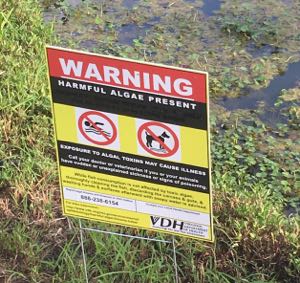HAB Impacts
 Algal blooms can impact both marine organisms and human health. They do so by producing toxins, clogging fish gills or abrading tissues, and other direct means.
Algal blooms can impact both marine organisms and human health. They do so by producing toxins, clogging fish gills or abrading tissues, and other direct means.
Algal blooms can also impact aquatic animals indirectly. As a bloom winds down and algal cells die and sink to the bottom, they provide a rich food source for bacteria, which in the act of decomposition consume dissolved oxygen from surrounding waters. This is a major cause of the low-oxygen dead zones that plague coastal waters worldwide.
Harmful algal blooms (HABs) are of growing concern worldwide as human activities lead to warmer, more nutrient-rich coastal waters.
Expand the selections below to learn more.
ToxinsDinoflagellate toxins are among the most potent biotoxins known. However, not all algal species produce toxins, and those capable of toxin production do so only under certain conditions. Moreover, a single algal species can generate more than one kind of toxin, while the same toxin can be produced by multiple species. For example, Anabaena, a cyanobacteria, can produce both neurotoxins and hepatotoxins, while saxitoxins, which cause paralytic shellfish poisoning, can be produced by both cyanobacteria and dinoflagellates. The level of toxicity also depends on a toxin’s chemical composition, which itself can vary widely. Microcystins, a class of toxins that damage the liver, have more than 80 different “congeners”—chemical variants with slightly different molecular structures and masses. Gaining a better understanding of toxins and the environmental conditions and algal species that produce them is a major focus of HAB research at VIMS. |
Transmission & ExposureDinoflagellates and other algae can release toxins directly into the water; toxins can also accumulate in shellfish or fish when these animals filter algal cells from the water for food. People that eat these seafoods may succumb to a constellation of different symptoms. People may also be exposed to algal toxins via drinking water, seafood, salt spray, and other vectors. Some dinoflagellates, notably Hematodinium, impact marine life directly as parasites of economically significant crustacean species, including the Chesapeake Bay blue crab Callinectes sapidus. |
Symptoms & SyndromesPeople that eat shellfish or fish harvested from an area experiencing a harmful algal bloom can succumb to syndromes such as paralytic shellfish poisoning (PSP), neurotoxic shellfish poisoning (NSP), diarrheic shellfish poisoning (DSP), or ciguatera fish poisoning. These syndromes involve a myriad of symptoms including nausea, vomiting, diarrhea, disorientation, difficulty breathing, mouth numbness, slurred speech, disorientation, paralysis, and even death. Exposure to algal toxins through drinking water, seafood, salt spray, and other vectors can induce symptoms ranging from minor skin irritations to intestinal sickness, respiratory failure, and death as well. |
Beach Closures & Health AdvisoriesWhen HABs detrimental to human health are present, the Virginia Department of Health (VDH) may temporarily close beaches and other waterways to swimming or fishing until blooms have ceased. For notification of beach closures, visit the VDH website, look for signs, and monitor media announcements. |
Shellfish AdvisoriesWhen HABs detrimental to human health are present, the Virginia Department of Health (VDH) may temporarily close shellfish harvesting until blooms have ceased and organisms have had time to metabolize toxins. For notification of shellfish advisories, visit the VDH website and monitor announcements in the media. |
By Region
Study of the harmful impacts of algal blooms is made difficult by the complex interplay between and among algal toxins, human health symptoms, and geographic distribution. The tables below summarize these interactions for the U.S. coastline and Chesapeake Bay. Note that none of the syndromes described below for the U.S. in general have been reported in association with exposure to Chesapeake Bay water.
United States
Toxins generated by algal blooms have impacted human health all along the U.S. coastline.
Chesapeake Bay/Mid-Atlantic
Although some of the species associated with some of the syndromes described above have been observed in Chesapeake Bay, to date there have no reports of these syndromes in association with exposure to Bay waters.
